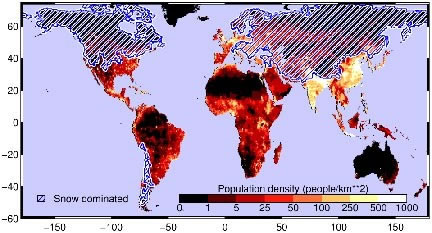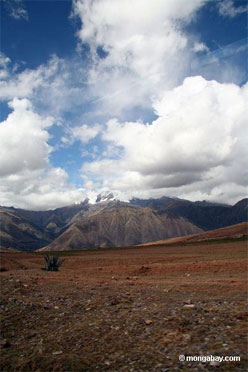Global warming will reduce glaciers, water supply and affect millions of people
UCSD news release
November 16, 2005
In the looming future, global warming will reduce glaciers and storage packs of snow in regions around the world, causing water shortages and other problems that will impact millions of people. That is the conclusion of researchers at Scripps Institution of Oceanography at the University of California , San Diego, and the University of Washington in a review paper published in the November 17 issue of the journal Nature.
In analyzing several scenarios, Scripps Institution’s Tim Barnett, and Jennifer Adam and Dennis Lettenmaier of the University of Washington, show that human-produced greenhouse gases, and the resulting warmer climates they produce, will have a significant influence on ice- and snow-dependent regions and will result in costly disruptions to water supply and resource management systems.
In fact, the authors argue that their predictions and observations “portend important issues for the water resources of a substantial fraction of the world’s population.”
The analysis first describes how water resource levels will change under global warming’s influence and then depicts impacts on regions in the western United States, Europe, Canada, Asia and South America.
According to the authors, the forces driving these changes—described as “greenhouse physics”—show that in a warming climate more water will fall in the form of rain rather than snow, filling reservoirs to capacity earlier than normal. Additionally, a warming climate will result in snow melting earlier in the year than in previous decades, disrupting the traditional timing of water available from snow runoff streams. Together, they say, these changes mean less snow accumulation in the winter and earlier snow-derived water runoff in the spring, challenging the capacities of existing water reservoirs. According to Barnett, water shortages will occur in areas where reservoir capacity cannot hold the annual cycle of rain/snow.
 Image courtesy of the Scripps Institution of Oceanography. |
“California , and in particular the Columbia Basin , doesn’t have enough dam capacity to hold a seasonal cycle of water,” said Barnett. “When you change the seasonality of how rivers flow you are essentially putting the water runoff all into spring rather than being able to draw it out through summer. Mother nature is not going to act like a reservoir as it has in the past and when the water comes out all at once there isn’t enough capacity to contain it.”
|
Related articles
Alaska – climate change causing ancient lakes and wetlands to be replaced by forest September 28, 2005 Glaciers melting at alarming rates, water problems feared September 7, 2005 Global warming shrinks sacred glacier in the AndesJuly 6, 2005 |
For Canada , the authors say earlier spring water runoff will threaten agricultural production in the Canadian Prairies. In Europe , hydrological simulations show that climate warming in the Rhine River Basin may reduce peak-demand water availability for industrial applications, agriculture and household uses. Ship transportation, flood protection, hydropower generation and revenue from skiing all could be threatened as a result.
In 2001, Barnett and other scientists with the Accelerated Climate Prediction Initiative estimated that vital water resources derived from the Sierra Nevada may suffer a 15- to 30-percent reduction in the 21 st century as a result of changes in snowpack runoff.
The authors of the new study extended these ideas to regions that heavily depend on glacier-derived water for their main dry season water supply. Such regions contrast with those that depend on water derived from snowpack, such as the western U.S. , where water supplies are replenished each year. Thus, the researchers warn that “even more serious problems may occur” in glacier dependent regions “because once the glaciers have melted in a warmer world, there will be no replacement for the water they now provide.”
Barnett, Adam and Lettenmaier say the most vulnerable region where vanishing glaciers will impact water supplies in the coming decades is China, India and other parts of Asia because of their potential to affect vast populations throughout this region. The ice mass in the mountainous area of this region is the third largest on Earth following Arctic-Greenland and Antarctica .
 Snow-capped mountain in Peru. Photo by R. Butler |
In South America, a significant fraction of the population west of the Andes Mountains similarly could be at risk due to shrinking supplies of glacier-derived river water. Glacier-covered areas in Peru , for instance, have experienced a 25 percent reduction in the past three decades, the authors note, and “at current rates some of the glaciers may disappear in a few decades, if not sooner.” Here again they warn that fossil water lost through glacial melting will not be replaced in the foreseeable future.
Adding to the complexity of these scenarios is determining the role of tiny atmospheric particles called aerosols. Such particles are believed to cool the planet’s surface and alter cloud processes. But while common aerosols such as black carbon are found in many regions around the world, their influence is not likely to reverse or even neutralize greenhouse warming, the authors say.
“Climate warming is a certainty in our future and the bottom line in this analysis is that we looked at the impact of the warming and the long-term prognosis is clear and very dire,” said Barnett. “It’s especially clear that regions in Asia and South America are headed for a water supply crisis because once that fossil water is gone, it’s gone.”
The research described in the Nature paper is a contribution from the International Detection and Attribution Group, jointly supported by the National Oceanic and Atmospheric Administration and the U.S. Department of Energy. The gross domestic product data set was developed by the Center for International Earth Science Information Network at Columbia University in Palisades, New York , with funding from the National Aeronautics and Space Administration.
This is a modified news release from UCSD. The original appears at Scripps-led Study Shows Climate Warming to Shrink Key Water Supplies around the World